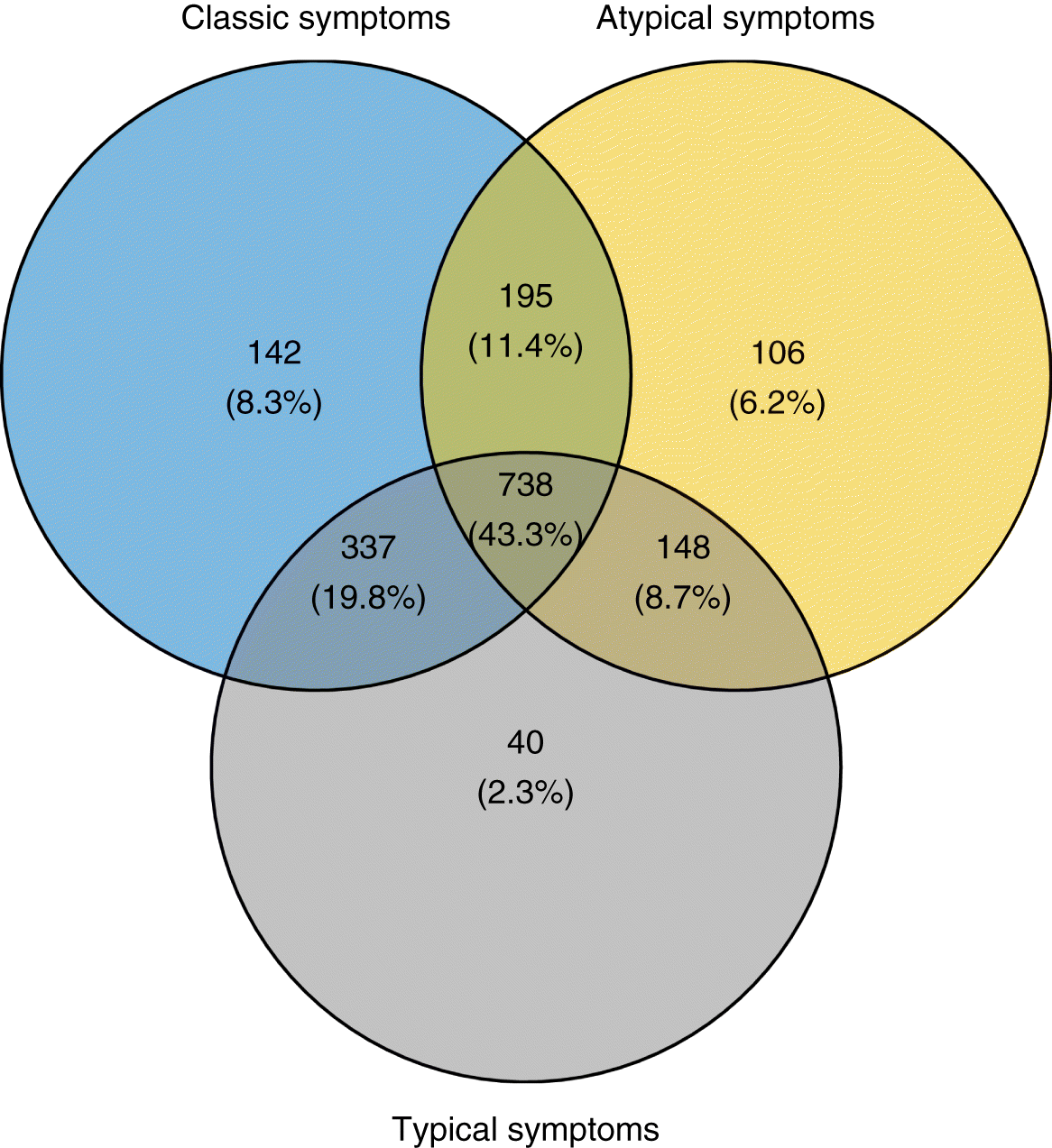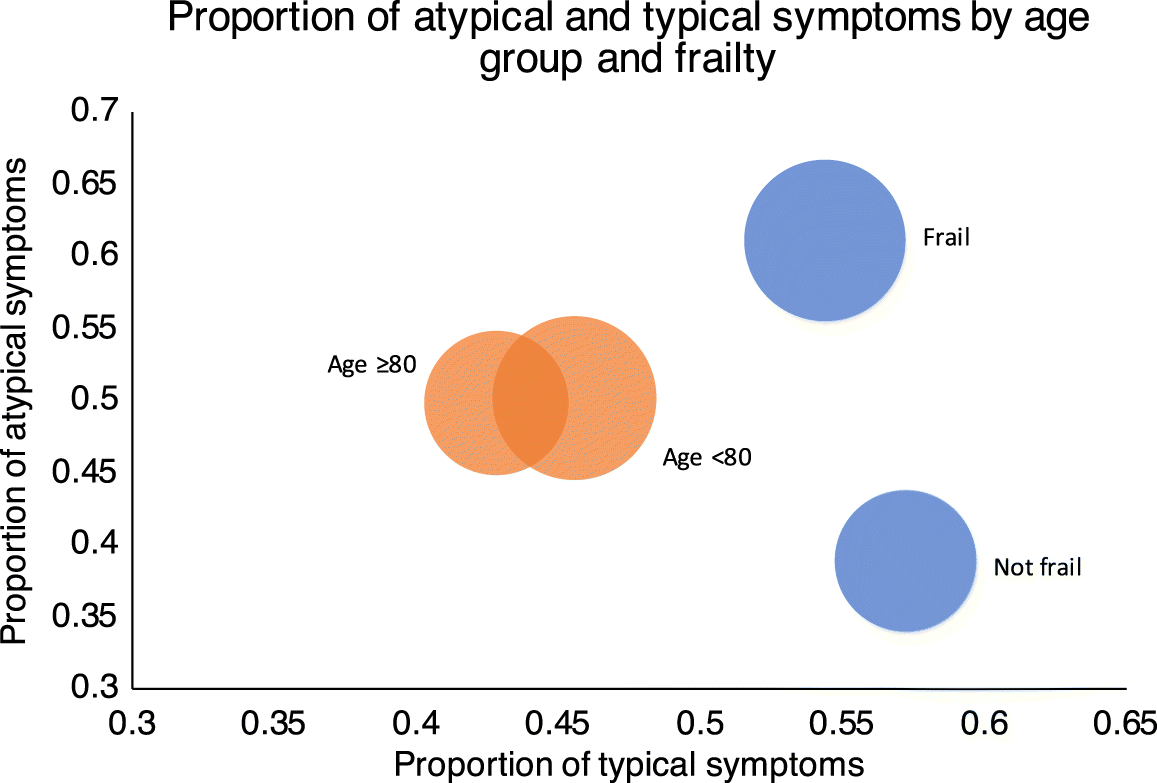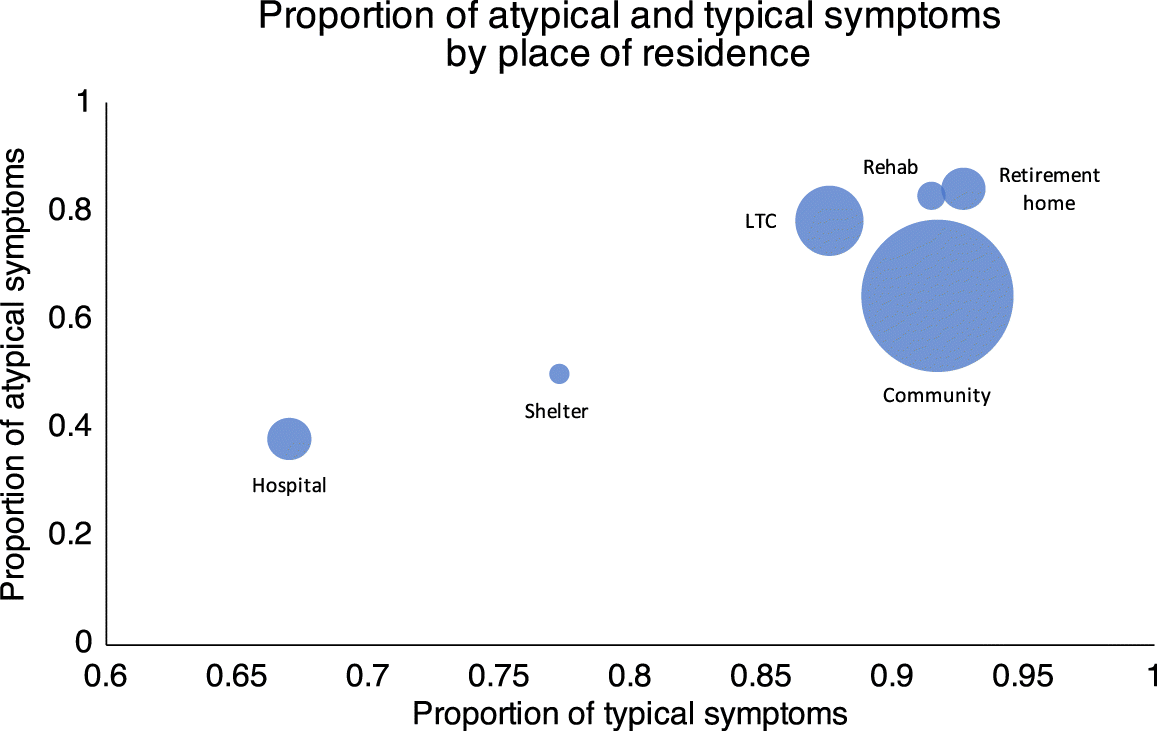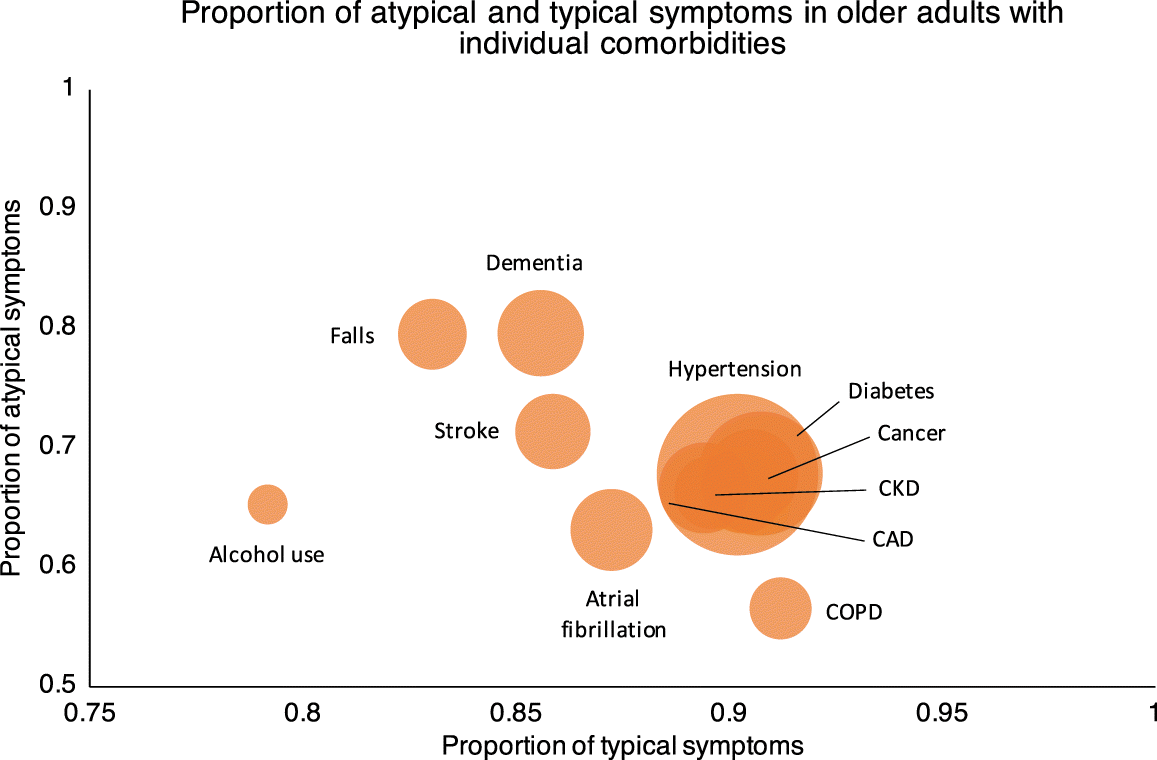Introduction
COVID-19 infection is associated with increased morbidity and mortality in older adults (
Guan et al. 2020). Studies early in the pandemic revealed that older adults frequently did not have typical symptoms, such as cough, fever, or shortness of breath (
Singhal et al. 2021). Atypical symptoms in older adults include geriatric syndromes, such as delirium, anorexia, or falls (
Singhal et al. 2021). These presentations are nonspecific to COVID-19 (
Hofman et al. 2017) and can occur with other diagnoses; as such, clinicians needed to increase their level of suspicion of COVID-19 infection in older adults. Atypical presentations in COVID-19 have been variably associated with mortality (
Gan et al. 2020). However, the definition of atypical presentation differs by study and it is often mixed with nongeriatric syndromes, such as abdominal pain or headache (
Gan et al. 2020). A geriatric-focused approach to the classification of COVID-19 symptoms would help better illustrate the spectrum of presentations.
As recurrent waves of the pandemic occurred across the world, new variants of COVID-19 emerged. Later variants, particularly the beta (B.1.351), gamma (P.1), and delta (B.1617.2) variants, were more virulent (
Fisman and Tuite 2021) and presented with different symptoms (
ZOE COVID Study 2021). In Ontario, Canada, wave 1 was predominantly caused by wild-type SARS-CoV-2 virus, while wave 2 was predominantly alpha variant (B.1.1.7), and wave 3 had increasing beta and gamma variants (
Public Health Ontario 2021). It is unknown whether clinical presentation changed in older adults across these three waves.
Furthermore, despite systematic reviews of early studies of COVID-19 symptoms (
Singhal et al. 2021), there is a lack of data looking at the way individuals with different comorbidities, place of residence, and frailty present. In particular, older age has been cited as the primary factor associated with atypical presentations of COVID-19, but it is unclear whether comorbidities and frailty also play a role.
Using a multicentre study of consecutively admitted older adults with COVID-19, the objectives of this study were to determine (i) the prevalence of each symptom and symptom category in older adults with COVID-19, (ii) the association of each symptom with in-hospital mortality, (iii) the change in symptoms with progressive waves of the pandemic, and (iv) whether clinical presentation differs by age, frailty, place of residence, and comorbidity.
Methods
This retrospective cohort study was done across seven hospitals in Toronto, Canada, from 1 March 2020 to 30 June 2021. Two sites had long-term care (LTC) and rehabilitation beds (Providence Healthcare and Baycrest Health Sciences). The remaining hospitals were acute care institutions (St. Michael’s Hospital, Mount Sinai Hospital, Sunnybrook Hospital, Toronto General Hospital, and Toronto Western Hospital). Each of these facilities cared for patients with COVID-19 infections. Research ethics approval was obtained through Clinical Trials Ontario (3186-OPIA-Apr/2020-38044). The protocol for this study was published on Open Science Framework (
osf.io/k4g7a/).
Inclusion criteria
1.
Patients with COVID-19 infection confirmed by viral polymerase chain reaction (PCR) swab available from hospital medical records. Patients received COVID-19 tests either by screening protocols or by clinical suspicion of disease.
2.
Age ≥65 years at the time of COVID-19 detection.
3.
Admitted to one of the acute care hospitals, rehabilitation facilities, or LTC homes listed above.
Exclusion criteria
1.
Re-admission to hospital after index admission for COVID-19. Only charts from the initial admission were included.
Data collection
Decision support services at each hospital network identified COVID-19 cases in patients age 65 years or older on a monthly basis. A trained chart assessor conducted the chart review of each identified case and completed the case report forms hosted on a secure REDCap server at the Applied Health Research Centre in St. Michael’s Hospital.
Since reports in the literature used various definitions of typical and atypical symptoms (
Davis et al. 2020;
Pritchard 2020), we created 3 categories of symptoms: (
i) classic, (
ii) typical, and (
iii) atypical. Classic symptoms (sometimes referred to as “typical symptoms” in the literature) included fever, cough, and shortness of breath. Our definition of typical symptoms included other symptoms (sometimes labelled as “atypical symptoms” in the literature) defined by the World Health Organization case definition of COVID-19 infection (e.g., rhinorrhea, diarrhea, nausea, and chills) (
World Health Organization 2020). We reserved the category of atypical symptoms for geriatric syndromes reported in the literature (
Emmett 1998;
Hofman et al. 2017), such as delirium, anorexia, and weakness. Symptoms were extracted from each patient’s chart, along with clinical frailty scale (CFS) (
Rockwood et al. 2005), place of residence, and significant past medical history. We used CFS classification from the original study (
Rockwood et al. 2005).
The waves of the pandemic were defined by dates provided by Toronto Public Health or on the date of the nadir of case counts between waves if a public health definition was not available. Wave 1 occurred from 11 March 2020 to 31 July 2020, using dates defined by Toronto Public Health (
City of Toronto 2021). Wave 2 spanned 1 August 2020 to 20 February 2021, which was defined by the nadir of case counts. Wave 3 occurred from 21 February 2021 until 30 June 2021, which was our predefined study end date.
The primary outcome was in-hospital mortality. Each chart was assessed for delirium on presentation from emergency room and admission notes using a validated chart review method (CHART-DEL) (
Saczynski et al. 2014). Each chart assessor completed a training module for determination of CFS, and extraction of CFS was regularly reviewed with a physician investigator. A training exercise was done on five charts where one of the physician investigators (BL, JW, EW, KP, TI, and AV) extracted chart data in duplicate with the chart assessor. After, the chart assessor regularly reviewed abstraction questions with the investigators. Five of the physician investigators were geriatricians (BL, JW, EW, KP, and TI) and one was a family physician (AV).
Data processing
The dataset was reviewed for any missing variables. Missing key variables (e.g., CFS, delirium, death) were flagged, and those charts were reviewed by a physician investigator. Error checking was done to identify variables outside of acceptable ranges. Summary variables were created for any atypical presentation, any typical presentation, any classic symptoms and any functional impairment. Missing CFS data was imputed as 6 (moderate frailty) for residents from LTC and 5 (mild frailty) for those from retirement homes or assisted living facilities based on local LTC admission criteria and published frailty estimates (
Muscedere et al. 2016). Missing frailty or functional status data from community dwelling patients were not imputed because of the diverse range of frailty levels in this cohort (
Kelly et al. 2017).
Analysis
Patient baseline characteristics were analysed descriptively with proportions, means (standard deviations), and medians (interquartile range), where appropriate. Comparisons of categorical variables were done by χ2 test and of continuous variables by ANOVA test. Non-normally distributed variables such as length of stay were compared using the Kruskal–Wallis test. The prevalence of each symptom was calculated by a proportion of exhibiting patients compared with the whole group.
Multivariable logistic regression models were used to identify independent association of symptoms for in-hospital mortality in older adults. Covariates of interest include age, sex, CFS, and total comorbidity count (based on documented past medical history). In the multivariable models, missing data were handled by listwise deletion. Statistical significance was defined at p ≤ 0.05. The analysis was done using R version 4.0.3.
Bubble plots were used to demonstrate the prevalence of typical and atypical symptoms in individuals grouped by age, frailty, place of residence, and comorbidity. For this analysis, we combined classic and typical symptoms into a single “typical symptoms” category so that we could plot the findings on two axes. The sample size of each plotted group was reflected in the circle size. Bubble plots were generated by Microsoft Excel.
Reporting standard
The Strengthening the Reporting of Observational Studies in Epidemiology (STROBE) Statement was used to write this manuscript (
Von Elm et al. 2007).
Discussion
In this cohort study of consecutive older adults admitted to hospital and LTC with COVID-19, we found that atypical presentations were common, but most patients presented with an overlap of atypical, typical and classic symptoms. Given the inconsistency in defining atypical symptoms in the literature (
Davis et al. 2020;
Pritchard 2020), we used three groups of symptoms to better describe the relationship between symptom types. The overlap in symptoms indicated that the presentation of COVID-19 in older adults was diverse. As such, a low threshold for testing is essential to detecting cases.
Fever (64%–70%), dyspnea (71%–73%), and cough (67%–96%) were common symptoms in older adults (aged ≥ 65) admitted to hospital with community-acquired pneumonia or influenza in pre-COVID studies (
Riquelme et al. 1997;
Walsh, Cox and Falsey 2002). Comparatively, the prevalence of these symptoms in our cohort was lower (46.6%–52.0%), suggesting that older adults with COVID-19 did not present as classically as respiratory infections of the past. A meta-analysis of COVID-19 studies in older adults from December 2019 to May 2020 revealed a weighted prevalence of 83% for fever, 60% for cough, and 42% for dyspnea. Increased virulence of the beta (B.1.351) and gamma (P.1) strains (
Public Health Ontario 2021), which predominated in the later waves in 2021, may have contributed to the higher proportion of dyspnea in our cohort (48.0%). Another explanation for higher dyspnea prevalence was the selection of sicker patients to be transferred from LTC to hospital given resource limitations at the time (
CBC News 2021) and from the community given increased recognition of symptoms requiring hospital treatment.
We defined atypical presentation as geriatric syndromes aligned with the clinical literature. Geriatric syndromes are phenotypes that arise from the interaction of frailty, multiple shared risk factors (e.g., cognitive impairment, gait instability, polypharmacy etc.) and the acute disease process (
Inouye et al. 2007). They may not have a single direct pathophysiologic link to COVID-19, but rather the combination of infectious process on a susceptible older adult. Anorexia (44%) and delirium (44%) were the most common atypical symptoms in older adults hospitalized for community-acquired pneumonia in a study from Barcelona, Spain (
Riquelme et al. 1997). In a cohort from Korea (
Jung et al. 2017), weakness (27.3%) and delirium (25.4%) were most common in older adults hospitalized with pneumonia. These findings mirror the most common atypical symptoms in our cohort. Studies of atypical presentations in older adults with COVID-19 mostly report on delirium (
Pranata et al. n.d.) and falls (
Gawronska and Lorkowski 2021), with fewer studies looking at anorexia, weakness, and other geriatric syndromes. One problem is the lack of consensus definition on which geriatric syndromes are most important to capture (
Inouye et al. 2007). Despite early concerns of isolated atypical presentations in older adults (
Solanki 2020), our study found few patients who presented with a geriatric syndrome alone without other symptoms (6.2%). The advocacy around atypical presentations raised awareness for case detection in this population, which helped improve protocols for LTC locally. Our findings highlighted the importance of understanding geriatric syndromes as part of disease presentations.
Using multivariable models, we determined that dyspnea, tachycardia, and delirium were independently associated with in-hospital mortality. Systematic review of pooled univariate analyses found similar associations with mortality for dyspnea (
Shi et al. 2021), tachycardia (
Shi et al. 2021), and delirium (
Pranata et al. n.d). Dyspnea and tachycardia are likely reflective of hypoxia, which is an important independent predictor for disease severity and mortality in COVID-19 (
Gallo Marin et al. 2021). Delirium is an independent predictor of mortality across medical and surgical patients in studies prior to COVID-19 (
Aung Thein et al. 2020). These symptoms, including delirium, can help clinicians decide which patients to send to hospital in repeated waves of the pandemic. LTC outbreaks are occurring again in Ontario as a result of the omicron variant (
McKenzie-Sutter 2021) and clinicians can use these symptoms along with oxygen saturation to determine which patients need medications or acute care treatment. Conversely, the presence of nausea, chills, and myalgias were independently associated with decreased in-hospital mortality. Previous studies have not found these associations (
McKenzie-Sutter 2021), but most studies were done when the wild type version of the virus was circulating. It is possible that certain variants trigger differing symptoms (
Public Health Ontario 2021). Nausea, chills, and myalgias are also not related to respiratory status or hemodynamic instability, perhaps reflecting milder disease.
We further analysed clinical presentation by place of residence and comorbidities. The proportion of atypical symptoms were higher for those from LTC and those who had falls or dementia on history. These populations were likely more frail, which predisposes them to geriatric syndromes (
Inouye et al. 2007). Patients from the community and those with common comorbidities like hypertension, diabetes, and coronary artery disease had relatively more typical symptoms as they were likely less frail. This finding suggests that in frail individuals with pre-existing geriatric syndromes attention should be given to atypical presentations and management should include prevention of geriatric complications (e.g., delirium, falls, medication adverse effects). Our analysis by frailty status and age confirmed that frailty was a relatively greater contributor to atypical presentations compared with age (
Fig. 2). Another finding from the bubble plot was that older patients with COPD often present with typical symptoms such as dyspnea or cough. Patients with COPD have upregulation of the angiotensin-converting enzyme 2 receptor in their airway epithelial cells, which is the primary target for spike protein attachment during a SARS-CoV-2 infection (
Higham et al. 2020). This allows for deeper and more severe infections in patients with COPD, which may result in predominantly respiratory symptoms, even early in the disease course (
Higham et al. 2020). The varying clinical presentations with different comorbidities should be explored in future studies to further aid detection and mechanistic understanding of the disease.
This study was limited by its retrospective design, which did not allow for prospective delirium assessment or collection of symptoms. Agreement was not assessed for the chart abstraction process, but each chart assessor was trained and supervised by a physician investigator through the study. Frailty data were based on the documented pre-admission baseline functional status, and data were missing for some patients because a functional inquiry was not always included in clinical notes. We imputed the CFS for patients admitted from retirement home and LTC in a conservative way, which may underestimate true frailty. The CFS data were also imputed at the chart abstraction stage. SARS-CoV-2 variant data was not available at all sites, so we did not report it in this study, which limited our ability to analyse symptoms by variant.
Strengths of this study included the use of a three-category classification of symptoms that allowed determination of the contribution of geriatric syndromes. Compared to other studies we included more geriatric-focused symptoms, such as incontinence, falls, and functional decline. We also included consecutively admitted older adults to eight hospitals and had a consistent chart review process at all sites, guided by a physician at each site. Delirium was abstracted using a validated chart review method (
Saczynski et al. 2014).





